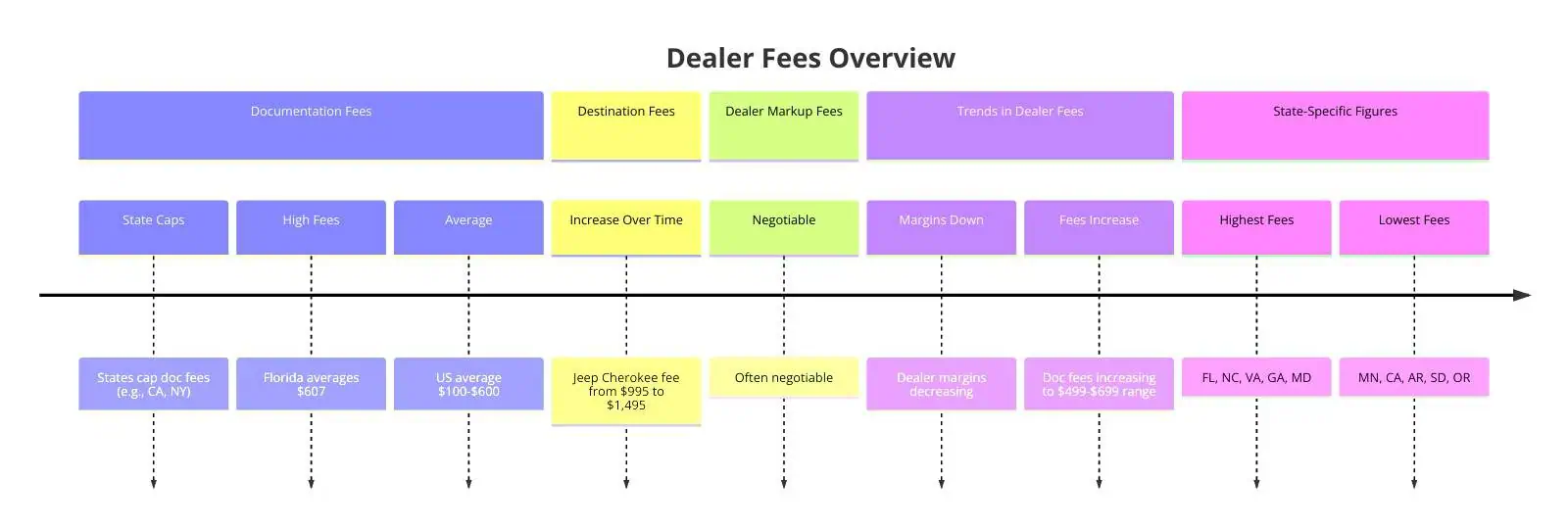

I wrote the article below to help prepare you for the negotiation process so you can identify, negotiate, and potentially eliminate dealer fees.

Dealer fees refer to charges imposed by a car dealership during the buying process, on top of the negotiated vehicle price. Some fees are non-negotiable, while others have room for negotiation.
There are three main categories of dealer fees to understand:
These include sales tax, registration and title fees. They are set by state governments and all buyers must pay them.
Charges for processing paperwork and other documentation. Often capped by states and may be negotiable.
Additional fees for things like advertising costs, preparation services and accessories. Typically negotiable if not vital.
Knowing these fee categories helps you pinpoint where negotiations might be possible.
Related Article: What is the VTR Fee?
I did some research and pulled the average dealer fees for 20 states along with whether that state has a cap in the total dealer fees that are permitted to be charged or not:
While specific fees vary, data shows the average buyer pays between 8% to 10% of the vehicle price in total dealer fees. Here are six of the most frequent extra charges:
Documentation charges to process DMV paperwork. Average is $382 nationally but over $700 in states like Florida.
Documentation fees, sometimes referred to as doc fees, refer to the handling and processing of paperwork required when purchasing a vehicle. Dealerships spend time preparing sales paperwork and charge buyers for this service.
Doc fees range widely from under $100 to several hundreds of dollars depending on location. Some states cap maximum doc fees – for example, California has a $85 limit.
Overall, you can expect median doc fees to be 1-3% of the total vehicle price. These charges cover administrative costs for title transfers and registration.
For transporting new cars to the dealer lot from manufacturing facilities. Now averages around $1,500 per vehicle.
Destination fees refer to the transportation costs incurred by dealerships to receive inventory from automakers. If you purchase a new car that needs delivery to the lot, expect to pay this vendor-to-dealer freight charge.
Destination fees vary based on vehicle and location, typically $900 to $3,000. You may pay less if buying an in-stock model since overland shipping wasn’t necessary.
Destination charges have increased steadily over recent years alongside vehicle pricing, largely due to increased fuel prices.
Dealers recouping a portion of advertising expenditure by passing costs to buyers. Can range from $300 to over $1,000.
Many dealers try to offset their advertising budgets by adding advertising fees to buyer invoices. These can either originate from manufacturers themselves or dealers tacking on additional charges above and beyond.
Advertising fees aren’t consistent across retailers and some dealers won’t charge them at all. If suddenly faced with a hefty advertising fee at time of purchase, you have grounds to contest it.
Price bumps for high-demand vehicles facing limited inventory. There is no regulation on amounts charged by dealers for this fee.
Market adjustment fees are additional markups that dealers apply to in-demand models facing constrained supply. Since these add-ons go straight to dealer profit, some add thousands for popular models.
Market adjustments should always be negotiable since they demonstrate willingness from the buyer to purchase at an elevated price point. Don’t hesitate to push back on egregious market fees that drastically inflate sticker pricing.
Charges for cleaning, inspection, and preparation to prepare vehicles for retail sale. Typically $100-$500.
Dealer prep fees cover costs like washing, detailing, mechanical inspections and reconditioning before vehicles are handed off to buyers.
These are intended to cover making cars retail-ready but often already fall under standard destination/transportation charges.
Since dealer prep is duplicative in many cases, buyers can try negotiating the fee amount or declining it if also paying destination costs. Consider the typical $150 dealer prep fee as part of the car price.
Additional financial products are offered through the dealership during financing. Pricing varies greatly.
Common add-ons pushed by dealer finance teams include Guaranteed Asset Protection (GAP) insurance. GAP covers the difference between vehicle value and remaining auto loan balance if the car is totaled, requiring borrowers to pay off less.
Whether GAP coverage makes sense depends on your down payment amount. With more equity in the vehicle, standard insurance payouts in case of loss close the gap more substantially. Carefully evaluate your situation before accepting GAP policies sold by the dealer, which carry large premium markups. Pricing is very subjective, product-to-product.